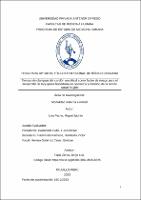Tiempo de clampaje del cordón umbilical como factor de riesgo para el desarrollo de taquipnea transitoria en neonatos a término de la red de salud Trujillo
Abstract
OBJETIVO: Determinar la asociación entre los tiempos de clampaje de cordón umbilical y el desarrollo de taquipnea transitoria en neonatos a término en EESS pertenecientes a UTES 6 Red de salud Trujillo, La Libertad – Perú durante el periodo abril – julio 2023.
MATERIAL Y METODO: El presente estudio fue de tipo observacional, analítico, de tipo cohorte prospectiva. La población estuvo conformada por 2 cohortes de neonatos a los que se les practicó un clampaje del cordón umbilical 120 segundos (grupo 1 control) y 180 segundos (grupo 2 expuestos), respectivamente. Posteriormente se evaluó la presencia de TTRN dentro de las 6 primeras horas de vida. Adicionalmente, se evaluó la asociación entre TTRN y clampaje a los 180 segundos, así como, con variables sociodemográficas y factores perinatales. Se utilizó modelos lineales generalizados (GLM), en regresión simple y múltiple para estimar la Razón de riesgo (RR).
RESULTADOS: Los resultados de asociación entre los tiempos de clampaje en 120 y 180 segundos fueron del 3.2% y 7.2% respectivamente. En cuanto a los factores perinatales: APGAR menor a 7 puntos al minuto, peso al nacer y lactancia materna inmediata fueron de 2.3%, 3265 ± 321.76 g y 97.3% respectivamente.
CONCLUSIONES: Los resultados encontrados para la asociación tiempo de clampaje a los 180 segundos y TTRN no fueron estadísticamente significativos para definir que el tiempo de clampaje sea un factor de riesgo para la incidencia de taquipnea transitoria en el recién nacido a término OBJETIVO: To determine the association between umbilical cord clamping times and the development of transient tachypnea in term neonates in HHFF belonging to UTES 6 Health Network Trujillo, La Libertad – Peru during the period April – July 2023.
MATERIAL AND METHODS: The present study is an observational, analytical, prospective cohort study. The population was made up of 2 cohorts of neonates who underwent umbilical cord clamping for 120 seconds (control group 1) and 180 seconds (group 2), respectively. Subsequently, the presence of TTN was evaluated within the first 6 hours of life. Additionally, the association between TTN and clamping at 180 seconds was evaluated, as well as with sociodemographic variables and perinatal factors. Generalized linear models (GLM) were used in simple and multiple regression to estimate the Risk Ratio (RR).
RESULTS: The association results between clamping times of 120 and 180 seconds were 3.2% and 7.2% respectively. Regarding perinatal factors: APGAR less than 7 points per minute, birth weight and immediate breastfeeding were 2.3%, 3265 ± 321.76 g and 97.3% respectively.
CONCLUSIONS: The results found for the association between clamping time at 180 seconds and TTRN were not statistically significant to define that clamping time is a risk factor for the incidence of transient tachypnea in the term newborn
Collections
- Medicina Humana [3196]


